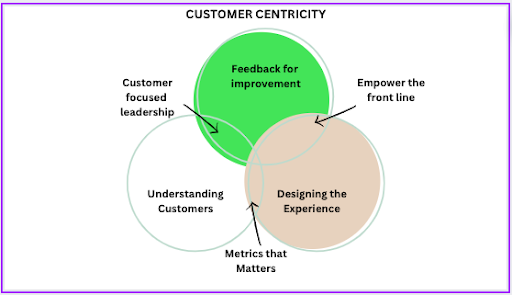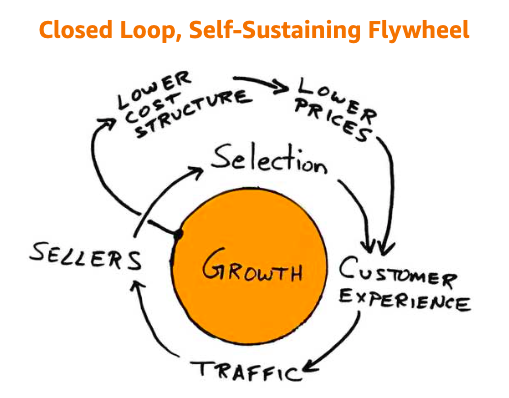Customer Centricity
Definition
“Customer Centricity” is a company’s strategy that prioritises consumers’ demands and preferences at each stage of the customer journey.
Description
Understanding and anticipating customers’ needs and designing products, services, and experiences that meet those needs most effectively and efficiently possible.

A customer-centric company focuses on building solid relationships with its customers, providing exceptional customer service, and creating a customer experience that is personalised, seamless, and enjoyable.
This approach requires a deep understanding of customer behaviour, preferences, and feedback and a commitment to continuous improvement and innovation.
In essence, customer-centricity is about putting the customer at the centre of everything a company does and using that focus to drive growth, loyalty, and long-term success.
Importance of Customer Centricity
Customer centricity is crucial for businesses that want to be successful in today’s competitive marketplace. Here are some of the key reasons why:
Increased customer satisfaction: By putting the customer at the centre of everything you do, you can create products, services, and experiences that truly meet their needs and desires. This can increase customer satisfaction and loyalty, driving repeat business and positive word-of-mouth referrals.
Competitive advantage: A customer-centric approach can help you differentiate your business from competitors. By offering a superior customer experience, you can stand out in a crowded marketplace and win more business.
Improved financial performance: Happy customers are more likely to spend more money with your business and refer others, leading to increased revenue and profitability.
Better customer insights: By focusing on the customer, you can gain valuable insights into their behaviour, preferences, and needs. This information can help you make more informed business decisions, develop better products and services, and effectively target your marketing efforts.
Continuous improvement: A customer-centric approach requires ongoing improvement and innovation. By constantly listening to customer feedback and making changes based on that feedback, you can stay ahead of the competition and continue to grow your business over time.
How to measure customer centricity?
Measuring the strength and the influence of customer centricity in an organisation is important as it helps to channelise the organisation’s activities towards the goal’s achievements.
Here are some key metrics and approaches that can help you assess the degree to which your business is customer-centric:
1. Customer satisfaction: One of the most important measures of customer centricity is customer satisfaction. Find out how satisfied the customers are through surveys, feedback forms, or other methods that allow you to gather feedback directly from your customers. A high level of customer satisfaction indicates that your business is excellently meeting your customers’ needs and desires.
2. Net Promoter Score (NPS): NPS is a popular metric that measures the likelihood of a customer recommending your business to others. It is calculated by subtracting the percentage of detractors (customers who would not recommend your company) from the percentage of promoters (customers who would recommend your business). A high NPS indicates that your business is excellently satisfying your customers and creating loyal advocates.

3. Customer retention rate: Another important metric for measuring customer centricity is customer retention. This measures the percentage of customers who return to your business after their initial purchase. A high retention rate indicates that your business is excellently building long-term relationships with your customers.
4. Customer lifetime value (CLV): CLV measures the total value a customer brings to your business over their relationship with you. A high CLV indicates that your business is booming at creating loyal customers who continue to make repeat purchases.

5. Employee engagement: Employee engagement is also an important factor in customer centricity. Engaged employees are more likely to provide exceptional customer service and create positive customer experiences. You can measure employee engagement through surveys, feedback forms, or other methods that allow you to gather feedback directly from your employees.
How to Create a Customer Centric Strategy For Your Business?
Creating a customer-centric strategy for your business involves several key steps:
- Understand your customers: The first step in creating a customer-centric strategy is to deeply understand your customers, their needs, desires, and pain points. Collect customer behaviour and preferences data, and use that information to inform your product and service offerings.
- Empower employees: Creating a customer-centric culture requires empowering employees to provide exceptional customer service. This means providing ongoing training and support and creating a work environment that fosters empathy and a deep understanding of customer needs.
- Personalised experiences: A vital component of a customer-centric strategy is personalization. Use data and technology to tailor experiences to individual customer needs and preferences, such as targeted marketing campaigns and personalised product recommendations.
- Optimise touchpoints: A truly customer-centric business must optimise the customer experience across all touchpoints, from the initial point of contact to the final purchase. This may involve improving the website or mobile app design, streamlining checkout and payment processes, and offering fast and reliable shipping and delivery options.
- Gather feedback: Finally, a customer-centric strategy requires ongoing feedback and iteration. Gather feedback from customers and employees regularly, and use that feedback to inform business decisions and improve the customer experience.
Anatomy of Customer Centricity
The anatomy of customer centricity involves several key components, including:
- Customer focus: At the core of customer centricity is a deep focus on understanding and meeting customers’ needs. This involves collecting and analysing data on customer behaviour, preferences, and feedback and using that information to design products, services, and experiences that truly meet their needs.
- Culture of empathy: A customer-centric company values empathy for customers and employees. This means creating a supportive and empowering environment for employees and providing the tools and resources they need to deliver exceptional customer service.
- Personalization: A customer-centric business takes a personalised approach to interact with customers, using data and technology to tailor experiences to individual needs and preferences. This may involve targeted marketing campaigns, personalised product recommendations, and customised customer support.
- Seamless experiences: Customer-centric companies prioritise creating seamless experiences for their customers, from the initial point of contact to the final purchase. This may involve optimising the user experience on your website or mobile app, providing fast and reliable shipping and delivery options, and offering easy returns and exchanges.
- Continuous improvement: A customer-centric business is committed to constant improvement and innovation. This means listening closely to customer feedback, incorporating that feedback into business decisions, and proactively seeking ways to improve the customer experience and stay ahead of the competition.
Example
One brand that is often cited as an example of customer-centricity is Amazon. Amazon focuses on the customer, from its extensive product selection to its fast and reliable delivery options, which is evident in everything they do. They have built their business around the customer experience, with features like personalised recommendations, easy returns, and a simple and intuitive shopping interface.

Amazon’s customer-centric approach has allowed them to become one of the most successful companies in the world, with a loyal and dedicated customer base.
They are constantly innovating and improving their services to better meet the needs of their customers, and they are known for listening closely to customer feedback and incorporating it into their business decisions.
Overall, Amazon’s commitment to putting the customer first has allowed them to build a brand synonymous with convenience, quality, and customer satisfaction.
FAQs:
Why is customer-centricity important?
Customer centricity is essential because it can increase customer satisfaction, loyalty, advocacy, improved financial performance, and competitive advantage.
By putting the customer at the centre of everything you do, you can create products, services, and experiences that truly meet their needs and desires.
How can I become more customer-centric?
Becoming more customer-centric involves several key steps, including collecting and analysing customer behaviour and preferences, empowering employees to provide exceptional customer service, creating personalised experiences for customers, optimising the customer experience across all touchpoints, and constantly seeking feedback and making improvements based on that feedback.
What are some common challenges to achieving customer centricity?
Some common challenges to achieving customer-centricity include limited access to customer data, lack of employee buy-in, outdated technology or processes, and difficulty measuring the impact of customer-centric initiatives.
These challenges may require new technology, cultural shifts, and ongoing education and training.
How can I measure the success of my customer-centric initiatives?
Measuring the success of your customer-centric initiatives requires a combination of quantitative and qualitative data, as well as a deep understanding of your customers and their needs.
Key metrics include customer satisfaction, Net Promoter Score (NPS), customer retention rate, customer lifetime value (CLV), and employee engagement.
In addition, gathering feedback directly from customers and employees can also be valuable in assessing the success of your customer-centric initiatives.
What are the three pillars of customer centricity?
These businesses rely on three key strategies: customer development, customer retention, and customer acquisition to establish and maintain a customer-centric business model.





We would love to have your opinion.